The Motorola Moto G4 and G4 Plus Review
by Brandon Chester on August 15, 2016 8:00 AM EST- Posted in
- Smartphones
- Lenovo
- Motorola
- Moto G
- Moto G4
GPU Performance
As I mentioned on the last page, moving from Snapdragon 410 to Snapdragon 617 doesn't really lead to a significant improvement in real-world CPU performance. What does improve is GPU performance, which is something that has always been a bit of a problem on low-end and mid-range smartphones. The 2015 Moto G used Qualcomm's Snapdragon 410 SoC. Snapdragon 410 uses Qualcomm's Adreno 306 GPU, which put the 2015 Moto G in a bit of an odd position because that same SoC was used in the significantly cheaper Moto E. Snapdragon 617 uses Adreno 405, which we've demonstrated as providing significantly faster performance than Adreno 306 in past reviews of other devices that use it. It's worth testing a device to ensure everything is working correctly even if you already have results for another device with the same SoC, and so I've run our 2016 GPU benchmarks on the Moto G4.
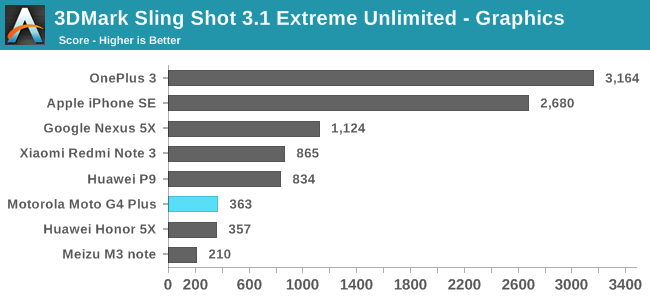
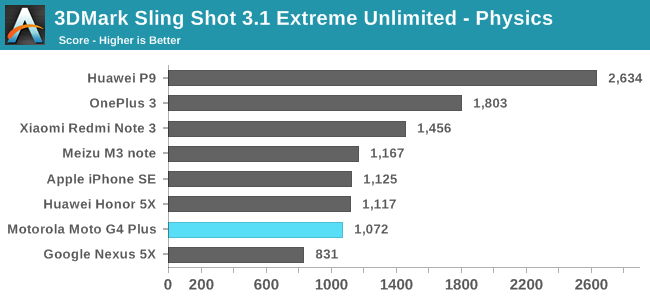
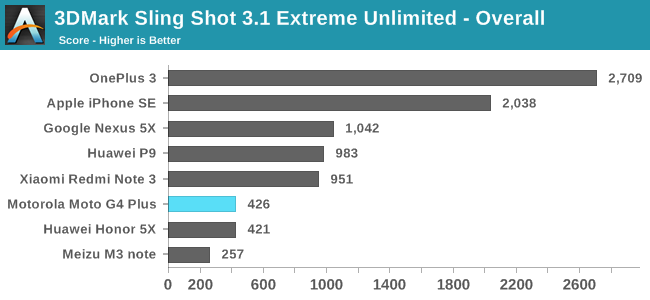
The 2015 Moto G doesn't support OpenGL ES 3.1, and so there's no way to run 3DMark Sling Shot Extreme Unlimited which uses ES 3.1 on Android and Metal on iOS. Snapdragon 617 uses the same Adreno 405 GPU as Snapdragon 615, and you can see in the results that the performance is right in line with the Huawei Honor 5X which uses Snapdragon 615. For a mid-range phone this is generally good performance, but once again the Xiaomi Redmi Note 3 sits far ahead of the rest of the mid-range smartphones, including the Moto G4.
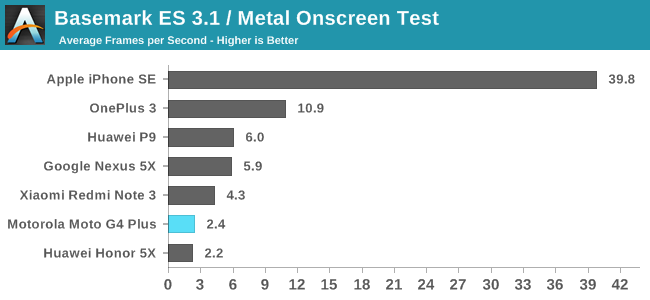
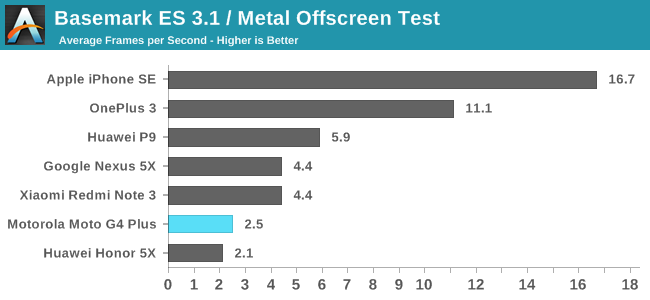
The situation in BaseMark ES 3.1 is the same as 3DMark, with the G4 Plus achieving roughly the same performance as the Huawei Honor 5X. The Xiaomi Redmi Note 3 with its Adreno 510 GPU ends up being a little over 75% faster, which is a huge improvement even if both devices technically don't get close to a playable frame rate in this very heavy test.
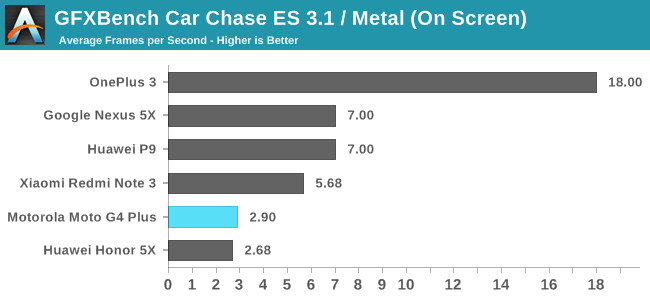
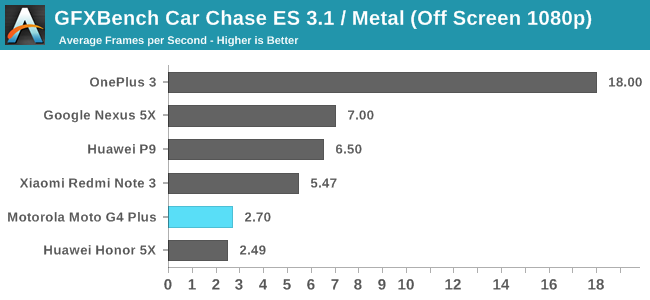
In GFXBench Car Chase it's the story is the same. The Moto G4 Plus is in line with other Adreno 405 devices, but the question is really whether or not that's good enough for a device launching this late into 2016.
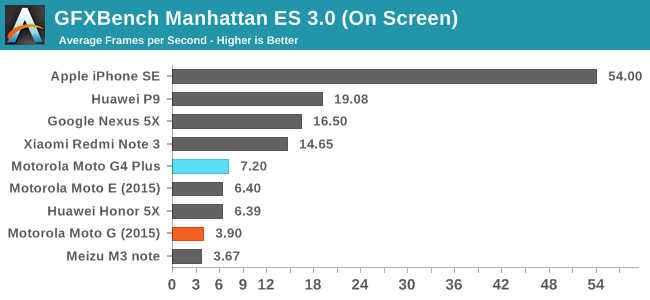
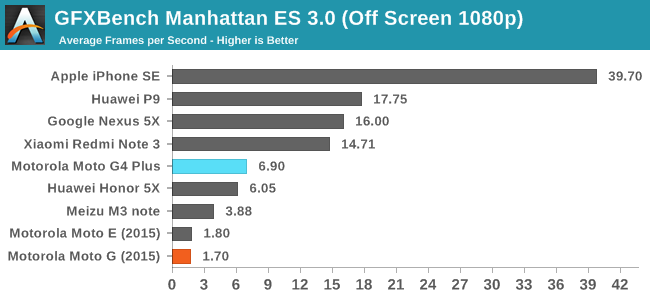
We've generally moved to Manhattan ES 3.1 / Metal for our reviews, but in cases like this where a device's predecessor doesn't support OpenGL ES 3.1 it's helpful to bring back Manhattan ES 3.0 to do a direct performance comparison. As expected, the Moto G4 is much faster than the 2015 Moto G, with on screen performance being about 85% faster despite the move from 720p to 1080p. and off screen performance being over four times faster.
It's clear that the Moto G4 provides much better GPU performance that the 2015 Moto G. However, much like the CPU benchmarks, I keep looking at the charts and seeing the Xiaomi Redmi Note 3 sitting well above the Moto G4. Adreno 405 is much better than Adreno 306, but Adreno 510 is two times faster than Adreno 405. I feel like the Moto G4 is simply launching too late for this kind of performance to be competitive, as it's tied with the Honor 5X which was launched at $200 nearly a year ago. While I don't mean to take away from the fact that the Moto G4 does provide faster GPU performance than its predecessor, I think there are devices right around the corner that are going to make a mid-range smartphone with Snapdragon 617 look decidedly last generation.
NAND Performance
NAND performance is still an area of concern on mid-range smartphones, but the situation has gotten better in recent times. The 2015 Moto E was an example of a device with very poor NAND performance, but the 2015 Moto G was significantly faster across the board. Motorola is still using eMMC memory, but there's definitely room for improvement over the 2015 Moto G even when sticking with an eMMC storage solution. To evaluate the Moto G4's storage performance I've run AndroBench 4.0 on both the 16GB Moto G4 and the 64GB Moto G4 Plus.
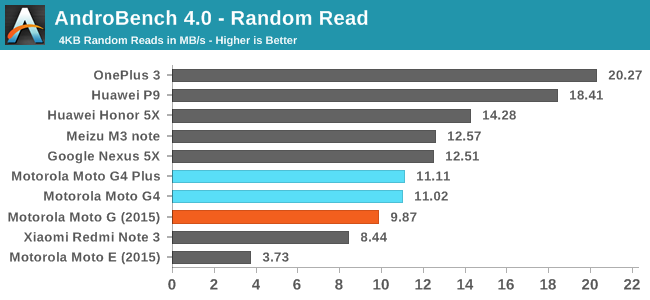
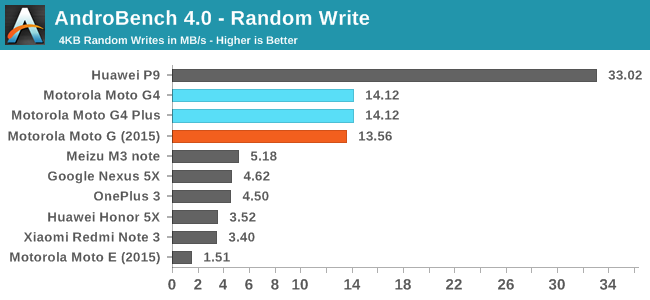
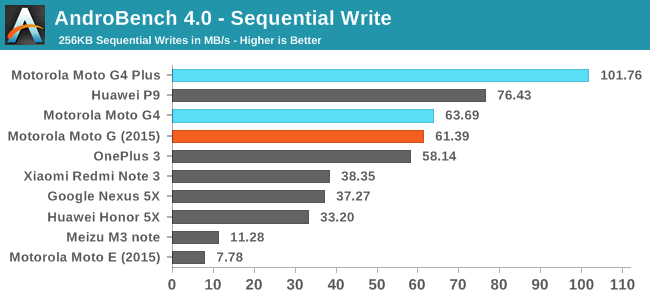

Among mid-range devices, the 64GB Moto G4 Plus performs very well. Random write results are ahead of all other devices on the chart except the Huawei P9, which isn't really a mid-range device and is just there for SoC comparisons. In the sequential write test the Moto G4 leads, which is due in part to the larger capacity allowing greater write parallelism. Sequential read performance is very good as well, although obviously not competitive with UFS 2.0 storage solutions like the one used in the OnePlus 3.










94 Comments
View All Comments
markiz - Tuesday, August 16, 2016 - link
Like, 80% of the time the phone is on it's back on the table.When I'm at work, and want to check out an IM or weather, or whatever, I don't pick it up, almost never. Faster (and stealthier) to keep it laying.
jabber - Monday, August 15, 2016 - link
Don't get why you would brand your phone the same as another G4. Most odd.zeeBomb - Monday, August 15, 2016 - link
Hey Brandon, do you think with the Nexus 5X, the HDR+ mode should be the go to mode like an auto mode for camera shots?grayson_carr - Monday, August 15, 2016 - link
When the 5X and 6P first came out, Anandtech always tested them with HDR+ enabled, but after 6 months or so, they decided that Google should stop being lazy and improve their image processing when not using HDR+ mode, so they started testing without HDR+ mode enabled.Brandon Chester - Monday, August 15, 2016 - link
Yes you should use HDR+. I have since stopped using it in reviews because it's not acceptable to take 1-2 seconds per shot for processing to get a usable image, and because HDR+ introduces exposure problems of its own. The quality of Google's normal processing is several years behind the best smartphones, and they need to do better.zeeBomb - Monday, August 15, 2016 - link
Wow :o from good to problematic in a short span if time...good to know. Thanks!Omega215D - Monday, August 15, 2016 - link
I'd advise against Motorola phones now that they are under Lenovo since the camera module on my Moto Z Force has suddenly worsened after a glitch when switching from regular Photo mode to Professional in which parts of the frame displayed exhibited what looked like broken LCD with top half in green and heavy artifacting and the bottom in red with heavy artifacting. Switching modes got it out of that but now photos taken in lower light settings are worse than my HTC One M8 which wasn't the case befor and Moto is slow to respond to my issue.Badelhas - Friday, August 19, 2016 - link
Yeah, since the "We will not update the Moto E 2015" controversy (8 month old popular smartphone) , Motorola lost all of the confidence I had in the company and I won't be suggesting one of their devices to anyone, ever.Hrel - Monday, August 15, 2016 - link
Sadly they made it bigger, 5.5" is too big. Why wouldn't they just leave it at 5" and do the 1080p screen?Just sad.
greyhulk - Monday, August 15, 2016 - link
Too big for you, maybe. That's the minimum size for me now.